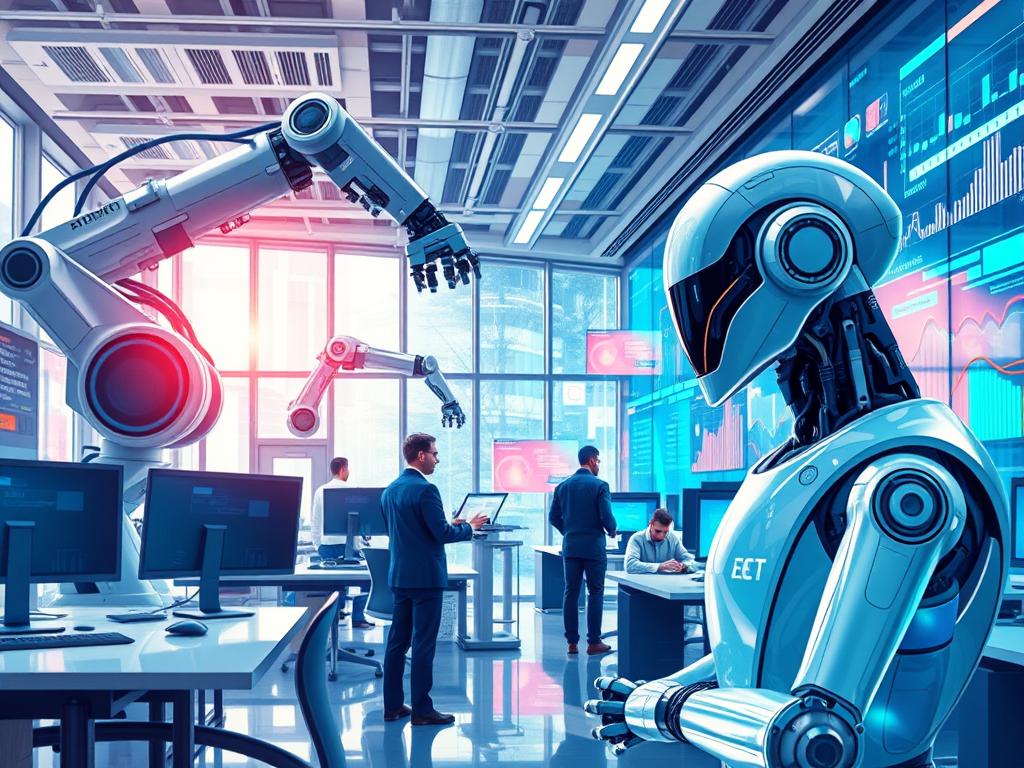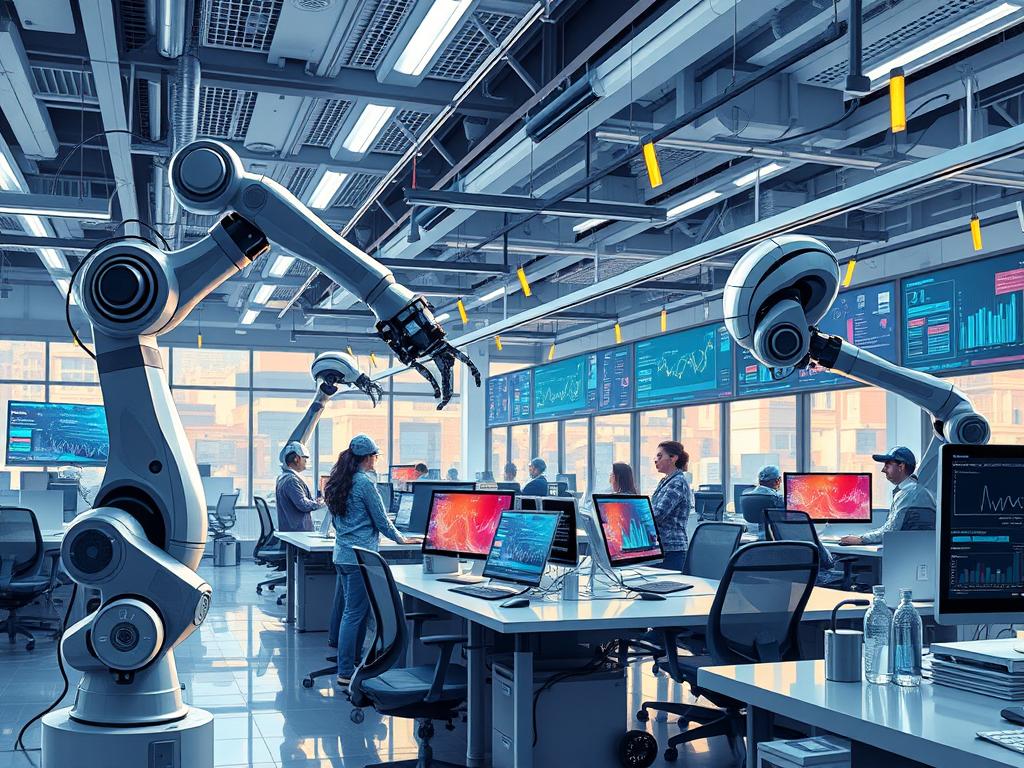Robotic Process Automation (RPA) can slash costs by 30-50% through task automation. This highlights the game-changing potential of robotic process automation AI in business. Companies are turning to RPA and AI to boost efficiency.
Intelligent automation merges RPA and AI technologies, transforming business operations. It combines rule-based automation with AI’s adaptive learning. This powerful duo tackles complex tasks and enables data-driven decision-making.
RPA AI integration is reshaping industries across the board. It’s driving innovation in finance, healthcare, customer service, and supply chain management.
Intelligent automation sets new standards for efficiency in the digital age. It empowers organizations to adapt quickly and make smarter choices. Discover how this tech combo can revolutionize your business operations.
Understanding Robotic Process Automation AI
Robotic Process Automation (RPA) and Artificial Intelligence (AI) are changing how businesses work. RPA tackles repetitive tasks efficiently. AI adds cognitive computing skills to the mix. Together, they make a powerful team.
Definition and Key Concepts
RPA copies human actions on computers for routine tasks. It’s 4-5 times faster than humans in data entry, with fewer mistakes.
AI mimics human thinking, making smart choices. It can sort emails or spot fraud like a person would.

How RPA and AI Work Together
RPA robots stay the same, but AI tools get smarter over time. They learn and understand language better with practice.
Companies use both technologies for different problems. AI adds skills like image and speech recognition to RPA.
Benefits of Integration
RPA and AI together create smart, independent automation. This teamwork brings many advantages:
- Increased throughput and efficiency
- Better SLA compliance
- Improved employee satisfaction
- Enhanced customer experiences
- Cost reduction
AI-powered automation helps businesses tackle complex jobs. It can study lots of data and adapt to new needs.
This RPA-AI combo leads to smarter, more efficient work across many industries.
Practical Applications Across Industries
Robotic process automation software is transforming operations in various sectors. The global RPA market is worth $5.7 billion and growing rapidly. RPA and AI are reshaping key industries in exciting ways.
RPA AI in Finance and Banking
RPA enhances fraud detection and loan processing in finance. Over half of large enterprises use RPA tools. These tools typically pay for themselves in less than a year.
Enhancing Healthcare Operations
RPA improves patient data management and claims processing in healthcare. In US hospitals, 43% of CFOs use RPA for revenue cycle automation. This boost in efficiency is transforming healthcare operations.
Transforming Customer Service with RPA AI
Customer service is evolving with AI and RPA chatbots. These technologies automate email responses and offer 24/7 support. RPA chatbots provide personalized interactions at scale, revolutionizing customer service.
“RPA implementations have a payback period of less than 12 months, making them an attractive investment for businesses across industries.”
RPA AI is a game-changer in finance, healthcare, and customer service. As more businesses adopt RPA, we’ll see new and innovative applications emerge. This technology is shaping the future of business operations.
Implementation Strategies for Businesses
Businesses need a smart plan to use AI in their work. By following a clear plan, companies can make their work much faster and better.
Steps to Successfully Integrate RPA AI
To use RPA and AI well, businesses should follow these steps:
- Set clear goals and identify automation opportunities
- Establish a Center of Excellence (CoE) for best practices
- Select the right automation platform
- Develop a strong business case with cost-benefit analysis
- Start with quick wins to gain executive buy-in
- Monitor key metrics during testing
The SS&C | Blue Prism® Robotic Operating Model™ (ROM2) can help use digital workers at a large scale. This plan covers strategy, workforce, design, development, and operations.

Common Challenges and How to Overcome Them
Using RPA AI can be hard sometimes. Here are some problems and ways to fix them:
- Lack of organizational buy-in: Engage stakeholders early and demonstrate quick wins
- Technical complexity: Opt for low-code or no-code automation platforms
- Resistance to change: Emphasize the human element in digital transformation
- Integration issues: Involve IT departments from the outset
- Scalability concerns: Choose vendors with adaptable solutions
By fixing these problems early, businesses can work better with automation. This helps them do well in their digital change journey.
Companies can increase efficiency through automation and make their business better for a long time.
“Digital transformation is an ongoing journey of monitoring, optimizing, and growing to achieve radical efficiencies and improved business performance.”
Measuring Impact and Success
Robotic process automation AI has transformed business operations across industries. Companies must track key performance indicators (KPIs) to measure its effectiveness. They also need to analyze return on investment (ROI) to gauge success.
Key Performance Indicators for RPA AI
Several crucial metrics help measure RPA AI success. These include cycle time reduction, error reductions, and quality output. Better productivity and motivated staff are also important indicators.
- Cycle Time Reduction: Compares process runtime before and after automation
- Error Reductions: Measures accuracy improvements post-automation
- Quality Output: Assesses if automated processes meet expected quality levels
- Better Productivity: Analyzes resource utilization and task completion rates
- Motivated Staff: Evaluates employee satisfaction through surveys and retention rates
These KPIs help businesses quantify the impact of robotic process automation AI on their operations. By tracking these metrics, companies can improve and optimize their RPA strategies.
Case Studies Demonstrating ROI
Several organizations have successfully implemented RPA AI, achieving significant ROI. These case studies show the power of RPA AI across various sectors.
| Company | Industry | RPA Implementation | Results |
|---|---|---|---|
| Dell EMC | Technology | Aligned RPA goals with business strategy | $2 million yearly savings |
| Close Brothers | Finance | Automated document reconciliation | Improved efficiency in wholesale finance |
| US Marine Corps | Military | Automated equipment maintenance | Significant efficiency gains |
By using natural language processing and machine learning, organizations can save costs and improve operations. These technologies offer substantial benefits across different industries.

To ensure long-term success, businesses should set up a Central Feedback Unit. This unit can monitor KPIs and optimize RPA projects. By measuring RPA performance metrics, companies can adapt to market changes.
Future Trends in RPA AI Technology
RPA and AI are quickly changing many industries. These technologies are merging to create smarter business processes. The future looks promising for intelligent automation and cognitive computing.
Innovations on the Horizon
RPA AI technology is set for significant growth. By 2025, 70% of companies may use digital business models. These models will rely on data-driven decision-making.
Many leaders plan to increase AI funding in 2024. Generative AI is joining forces with intelligent automation. This creates more advanced digital worker processes.
RPA solutions are becoming more comprehensive. They’re now easier for non-experts to use. Ethical automation and ESG compliance are gaining importance.
Potential Risks and Ethical Considerations
RPA AI technology brings new opportunities and challenges. Data quality is crucial for successful RPA use. Companies need strong systems to manage different data models.
The tech can boost productivity and cut costs. However, job loss and privacy concerns remain. Businesses must carefully address these ethical issues.
As AI becomes part of automation plans, companies face important decisions. They must balance progress with responsible use of technology.


